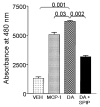Microglial responses to dopamine in a cell culture model of Parkinson's disease
- PMID: 18325635
- PMCID: PMC2762863
- DOI: 10.1016/j.neurobiolaging.2008.01.001
Microglial responses to dopamine in a cell culture model of Parkinson's disease
Abstract
Activated microglia appear to selectively attack dopamine (DA) neurons in the Parkinson's disease (PD) substantia nigra. We investigated potential mechanisms using culture models. As targets, human SH-SY5Y cells were left undifferentiated (UNDIFF) or were differentiated with retinoic acid (RA) or RA plus brain-derived neurotrophic factor (RA/BDNF). RA/BDNF-treated cells were immunoreactive for tyrosine hydroxylase and the DA transporter, took up exogenous DA, and released DA after K(+) stimulation. Undifferentiated and RA-treated cells lacked these characteristics of a DA phenotype. Co-culture of target cells with human elderly microglia resulted in elevated toxicity in DA phenotype (RA/BDNF) cells. Lipopolysaccharide (LPS) plus K(+)-stimulated DA release enhanced toxicity by 500-fold. DA induced microglial chemotaxis in Boyden chambers. Spiperone inhibited this effect. Cultured human elderly microglia expressed mRNAs for D1-D4 but not D5 DA receptors. The microglia, as well as PD microglia in situ, were also immunoreactive for D1-D4 but not D5 DA receptors. These findings demonstrate that activated microglia express DA receptors, and suggest that this mechanism may play a role in the selective vulnerability of DA neurons in PD.
Conflict of interest statement
There are no actual or potential conflicts of interest that the authors have.
Figures









Similar articles
-
Parkinson's disease cybrids, differentiated or undifferentiated, maintain morphological and biochemical phenotypes different from those of control cybrids.J Neurosci Res. 2013 Jul;91(7):963-70. doi: 10.1002/jnr.23241. Epub 2013 May 7. J Neurosci Res. 2013. PMID: 23653325
-
Dopamine receptors in human embryonic stem cell neurodifferentiation.Stem Cells Dev. 2013 May 15;22(10):1522-40. doi: 10.1089/scd.2012.0150. Epub 2013 Feb 19. Stem Cells Dev. 2013. PMID: 23286225 Free PMC article.
-
Quantitative Characterization of Phenotypical Markers After Differentiation of SH-SY5Y Cells.CNS Neurol Disord Drug Targets. 2020;19(8):618-629. doi: 10.2174/1871527319666200708132716. CNS Neurol Disord Drug Targets. 2020. PMID: 32640966
-
Neuroinflammation in Alzheimer's disease and Parkinson's disease: are microglia pathogenic in either disorder?Int Rev Neurobiol. 2007;82:235-46. doi: 10.1016/S0074-7742(07)82012-5. Int Rev Neurobiol. 2007. PMID: 17678964 Review.
-
SH-SY5Y human neuroblastoma cell line: in vitro cell model of dopaminergic neurons in Parkinson's disease.Chin Med J (Engl). 2010 Apr 20;123(8):1086-92. Chin Med J (Engl). 2010. PMID: 20497720 Review.
Cited by
-
Regulation of the Neurodegenerative Process Associated to Parkinson's Disease by CD4+ T-cells.J Neuroimmune Pharmacol. 2015 Dec;10(4):561-75. doi: 10.1007/s11481-015-9618-9. Epub 2015 May 28. J Neuroimmune Pharmacol. 2015. PMID: 26018603 Review.
-
Differential Regulation of Adhesion and Phagocytosis of Resting and Activated Microglia by Dopamine.Front Cell Neurosci. 2018 Sep 11;12:309. doi: 10.3389/fncel.2018.00309. eCollection 2018. Front Cell Neurosci. 2018. PMID: 30254570 Free PMC article.
-
"Reframing" dopamine signaling at the intersection of glial networks in the aged Parkinsonian brain as innate Nrf2/Wnt driver: Therapeutical implications.Aging Cell. 2022 Apr;21(4):e13575. doi: 10.1111/acel.13575. Epub 2022 Mar 9. Aging Cell. 2022. PMID: 35262262 Free PMC article. Review.
-
The Role of Glia in Addiction: Dopamine as a Modulator of Glial Responses in Addiction.Cell Mol Neurobiol. 2022 Oct;42(7):2109-2120. doi: 10.1007/s10571-021-01105-3. Epub 2021 May 31. Cell Mol Neurobiol. 2022. PMID: 34057683 Free PMC article. Review.
-
High-Resolution Imaging of Mitochondria and Mitochondrial Nucleoids in Differentiated SH-SY5Y Cells.Methods Mol Biol. 2022;2431:291-310. doi: 10.1007/978-1-0716-1990-2_15. Methods Mol Biol. 2022. PMID: 35412283
References
-
- Akiyama H, McGeer PL. Microglial response to 6-hydroxydopamine-induced substantia nigra lesions. Brain Res. 1989;489:247–253. - PubMed
-
- Akiyama H, McGeer PL. Brain microglia constitutively express beta-2 integrins. J Neuroimunol. 1990;30:81–93. - PubMed
-
- Arimoto T, Bing G. Up-regulation of inducible nitric oxide synthase in the substantia nigra by lipopolysaccharide causes microglial activation and neurodegeneration. Neurobiol Dis. 2003;12:35–45. - PubMed
-
- Chang RC, Hudson PM, Wilson BC, Liu B, Abel H, Hong JS. High concentrations of extracellular postassium enhance bacterial endotoxin lipopolysaccharide-induced neurotoxicity in glia-neuron mixed cultures. Neuroscience. 2000;97:757–764. - PubMed
-
- Chen H, Zhang SM, Hernan MA, Schwarzschild MA, Willet WC, Colditz GA, Speizer FE, Ascherio A. Nonsteroidal anti-inflammatory drugs and the risk of Parkinson disease. Arch Neurol. 2003;60:1059–1064. - PubMed
Publication types
MeSH terms
Substances
Grants and funding
LinkOut - more resources
Full Text Sources
Other Literature Sources
Medical
Research Materials

